After a difficult year-plus for manufacturing globally, some might say the future looks bright. But for LEO Lane, the future more accurately looks digital.
“If you’re a supply chain manager right now, you have to prepare for the next failure and that means moving to a digital supply chain,” says Lee-Bath Nelson, co-founder and vice president of business. “But if you don’t secure that digital supply chain, there’s no trust in it.”
Israel-based LEO Lane has developed a software-as-a-service (SaaS) product designed to ensure that trust for the additive manufacturing (AM) supply chain. The company’s solution protects the IP around a 3D printable part, securing not only its geometry but also how, where and how many times that part can be made. The company has just publicly announced its partnership with 3D printer manufacturer HP, a collaboration that integrates LEO Lane capabilities with the HP ecosystem. HP users and their customers can now use this capability to ensure secure AM production, as well as repeatability and traceability.
Securing Digital Manufacturing Data
LEO Lane’s SaaS solution is a means of “enclosing” the digital data about a 3D printable part in a secure package. That digital file lives on the local server of the designer or manufacturer, but a small piece is stored separately in the cloud as an encryption key for security purposes. Each part is treated as a “Limited Edition Object,” or LEO, that can only be manufactured in the quantity permitted by the originator of the part. Within the LEO file, the design’s owner can dictate exactly how that part is produced including the material it is made from, the settings it is printed with and the 3D printer that will build it.
LEO Lane’s integration with HP’s production technology was supported and enabled by the application programing interfaces (APIs) built into the latter’s Multi Jet Fusion (MJF) platform. HP users and their customers can now utilize LEO files to “talk” to these printers. “The software is asking questions of the machine, and now is getting answers,” Nelson says.
In practice, means better control and insight into how 3D printed parts are produced. For example, a customer needing just five instances of a part made from PA12 nylon on the Multi Jet Fusion 5200 platform can dictate these instructions within the LEO file. But the software goes one step beyond instructing — because of the two-way communication possible between software and printer, it can also enforce these requirements. Should the manufacturer attempt to alter the design, make an extra part, change the material, or print the items on an MJF 4200 printer instead, it would be blocked from doing so. In an application that must be made on a certified machine, the LEO file can even restrict production to a specific 3D printer’s serial number.
This system is restrictive, yes, but it is also enabling. The controls built into the LEO file are aimed at reducing risk, which in turn enables production necessities such as repeatability, security and traceability. HP users and their customers will be able to trust that their parts were made accurately while keeping their data secure. Digital inventories and distributed manufacturing — and more specifically, robust supply chains that trust in these advances — will be possible as a result.
Distributed Manufacturing Across Machines, Businesses
Part-level control and security is the main focus of the HP collaboration for now, but Nelson sees broad implications for this and other integrations. The ability to tie print instructions to a secure part file could be a solution for reallocating work across machines, for instance. If the software can dictate the settings needed for certified aerospace production, it may no longer be necessary to keep certain 3D printers dedicated only to the production of these parts. A certified yet idle machine could be applied to make other non-aerospace parts until its capacity can be filled again, at which point the software would mandate switching back to the aerospace certification settings. Enforcing such stringency manually would be nearly impossible, Nelson notes.
“Humans are prone to error, and additive is sensitive to that,” she says. “But certifying a machine and saying ‘Don’t touch it’ is not the best use of that capacity.” Controls built into part files support this flexibility, and also enable easier machine operation with less reliance on institutional knowledge and personnel expertise — a potential advantage for an industry that needs talent, and where advanced education is often a de facto requirement today.
“This will allow more additive manufacturers to use best-of-breed knowledge without the originator losing their competitive edge.”
Distributed manufacturing across facilities and 3D printing users could be easier and more efficient as well. LEO Lane has recently introduced “LEO recipes,” part setting configurations that allow 3D printing users to share their expertise with other manufacturers while keeping their process knowledge private. A medical manufacturer that becomes overloaded in the face of an emergency, for instance, could outsource some production with the recipe, allowing a third-party provider to properly produce the needed parts without exposing their own process knowledge and customer’s IP.
“This will allow more additive manufacturers to use best-of-breed knowledge without the originator losing their competitive edge,” Nelson says.
Supply Chain Disruptions in the New Normal
While these opportunities are still forthcoming, their promise is increasingly relevant. The manufacturing space in 2021 is primed for secure, repeatable, traceable and digital production in a way it perhaps wasn’t when LEO Lane introduced its capabilities a couple of years ago, Nelson notes. Manufacturers are seeing the need for a system that can establish trust in digital manufacturing workflows, as the need for these workflows has become more urgent in the face of recent supply chain disruptions.
Where in the past these challenges might have been seen as isolated failures, “Covid caused repeated failures, and we now recognize that there will be supply chain failures in the future,” she says. “If you build that infrastructure during regular times, you can be prepared for the next failure.”
Related Content
3D Printed Cutting Tool for Large Transmission Part: The Cool Parts Show Bonus
A boring tool that was once 30 kg challenged the performance of the machining center using it. The replacement tool is 11.5 kg, and more efficient as well, thanks to generative design.
Read MoreAdditive Manufacturing Production at Scale Reveals the Technology's Next Challenges: AM Radio #28
Seemingly small issues in 3D printing are becoming larger problems that need solutions as manufacturers advance into ongoing production and higher quantities with AM. Stephanie Hendrixson and Peter Zelinski discuss 6 of these challenges on AM Radio.
Read MoreLightweight Components: A Paradox When Machining
Today’s computer software can just as easily generate lightweight shapes for subtractive processes as it can for additive ones, but it increases cost and waste to make them.
Read MoreAircraft Engine MRO: How Additive Manufacturing Plus Robotic Finishing Will Expand Capacity for Blade Repair
AM offers the chance to bring fast, automated processing to individualized, part-by-part restoration of turbomachinery. A cell developed by Acme Manufacturing and Optomec is able to automatically repair 85,000 unique aircraft engine blades per year.
Read MoreRead Next
Where Blockchain and 3D Printing Converge, Distributed Manufacturing Can Thrive
Decentralizing production through additive manufacturing can bring numerous benefits, but these can only be realized through trust. VeriTX is building a platform to secure a trusted digital supply chain for aerospace and beyond.
Read MoreAM 101: Multi Jet Fusion (MJF)
From functional prototypes to end-use parts, HP’s Multi Jet Fusion (MJF) is capable of efficient production. Learn about MJF, including its materials, postprocessing requirements, benefits and more, in this 101 post.
Read More4 Ways the Education and Training Challenge Is Different for Additive Manufacturing
The advance of additive manufacturing means we need more professionals educated in AM technology.
Read More

.jpg;width=70;height=70;mode=crop)















